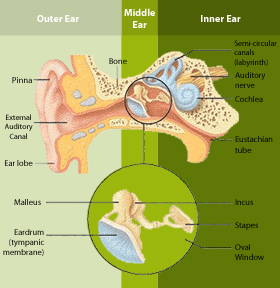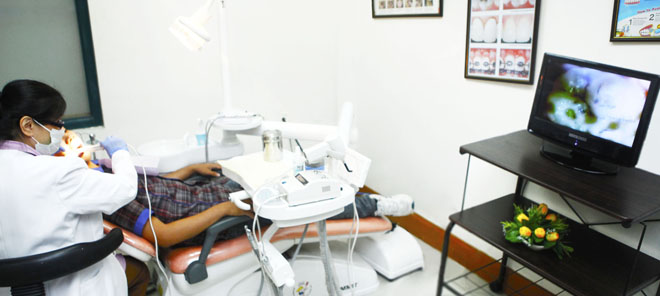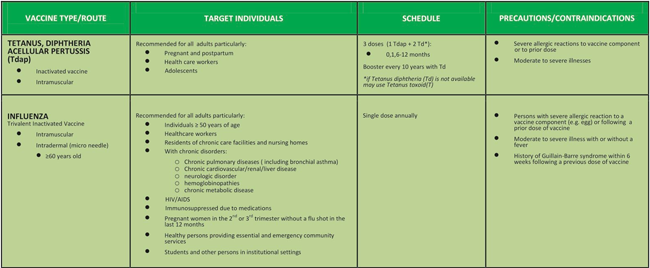Gallery of Services

Click the tabs to view description of our Services:
Post-medical Examination
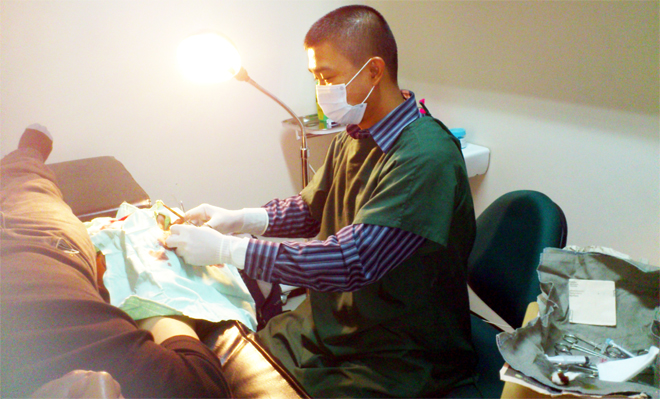
The post-medical examination applies to seafarers and land-based overseas workers who have completed their Pre-Employment Medical Examination (PEME) but who, on the following situations:
- got sick or injured at any time prior to departure
- have embarked on their respective tour of duties abroad but were repatriated due to accidents and other medical grounds
These seafarers and overseas land-based workers upon their return to the Philippines are attended to by in-house physicians of Medway Healthcare Inc. and co-managed by the accredited specialists. Close coordination with hospitals and physical/occupational therapy centers is also facilitated when necessary. Post-medical examination reports are furnished to the referring companies or agencies at the soonest possible time.
Outpatient Medical Consultation and Minor Surgical Procedures

MedWay Health Cardholders, Health Maintenance Organization (HMO) members and beneficiaries as well as walk-in patients may seek medical consultation with our in-house physicians and accredited specialists.
Minor surgical operations are also being performed under standard operating procedures, namely:
Minor Surgical Procedures
|
|
Electrocautery of Warts |
Corporate Medical Examination

Fostering its commitment to a healthy lifestyle in the workplace and reduction of health risks among employees, MedWay Healthcare Inc. provides medical packages that are adapted and tailored-fit to the needs of the company for:
- Annual physical examination
- Wellness program
Full Body Musculoskeletal Assessment
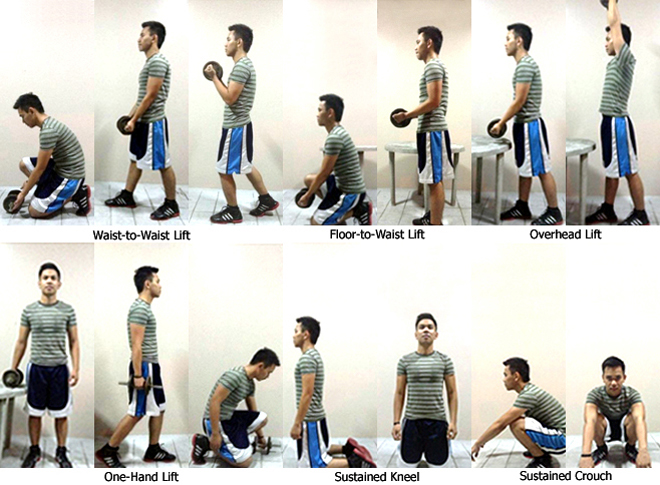
On top of the routine physical examination being conducted on patients, a full body musculoskeletal assessment may also be performed depending on the requirements of principals and employers. This is done to ensure that the patient is medically stable to work at the job he/she is applying for.
The full body musculoskeletal assessment consists of:
Musculoskeletal Examination – specific tests and maneuvers are carried out by an orthopedic specialist or health examiner as the patient is examined in the following positions:
- Standing
- Supine
- Prone
Strength and Mobility Testing – to determine if the patient has the necessary strength and conditioning to work safely at the jobsite; emphasis is given not only on lifting weights similar to those found at the jobsite but also on the correctness of lifting techniques in these various positions:
- Floor-to-Waist Lift
- Waist-to-Waist Lift
- One-Hand Lift
- Overhead Lift
- Long Carry
- Sustained Kneel
- Sustained Crouch
- Sustained Trunk Flexion
Fully Automated Laboratory Examination

In addition to the list below of minimum services required of a secondary laboratory like MedWay Healthcare Inc. (Department of Health 2007), please click the link to view the other services permitted to be offered by MedWay Healthcare Inc. as manifested in its License-to-Operate (LTO) certificate.
| Hematology | Urine | Stool | Clinical Chemistry |
|
|
|
|
Reference:
Philippines. Department of Health. August 22, 2007. Administrative Order No. 2007-0027, Subject: Revised Rules and Regulations Governing the Regulation and Licensure of Clinical Laboratories in the Philippines. Posted September 21, 2007. Accessed September 1, 2012. http://home.doh.gov.ph/ao/ao2007-0027.pdf.
Mobile and Home Service
MedWay Healthcare Inc. provides mobile laboratory collection service right in the comfort of your home.
Click here to send us your inquiries.
HIV Testing

Being a licensed clinical laboratory, MedWay Healthcare Inc. has also been given permission by the Bureau of Health Facilities and Services (BHFS) of the Department of Health (DOH) to operate an HIV testing laboratory. Manning this section is a full-time, licensed medical technologist with training in HIV Proficiency Testing (Department of Health 2005).
Moreover, in compliance with Article III Section 20 of Republic Act 8504 otherwise known as the “Philippine AIDS Prevention and Control Act of 1998,” MedWay Healthcare Inc., through its DOH-certified HIV counsellor, provides and conducts free pre-test counselling and post-test counselling for patients who avail of the HIV/AIDS testing services (Congress 1998).
References:
Philippines. Congress. February 6, 1998. Republic Act 8504: The Philippine AIDS Prevention and Control Act of 1998. Accessed September 1, 2012. http://www.pnac.org.ph/uploads/documents/about-pnac/RA8504.pdf.
Philippines. Department of Health. August 15, 2005. Administrative Order No. 2005-0027, Subject: Rules and Regulations Governing the Regulation of HIV Testing Laboratories. Posted October 13, 2005. Accessed September 1, 2012. http://home.doh.gov.ph/ao/ao2005-0027.pdf.
Drug Testing
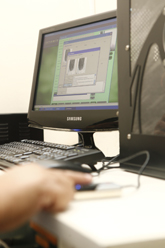
Drug testing at MedWay Healthcare Inc. is linked to the Integrated Drug Testing Operations Management Information System (IDTOMIS) of the Department of Health to ensure the quality and safeguard the validity of test result. Being an IDTOMIS-accredited Drug Testing Laboratory (DTL), MedWay Healthcare Inc. has been given access to download and install the DTO Client Windows Application software used for the system.
On hand to run the drug testing laboratory is the Laboratory Head, a licensed physician with certification in Clinical Pathology from the Philippine Board of Pathology (Department of Health 2003). Under the supervision of the Laboratory Head is a registered medical technologist with appropriate training in screening test procedures for dangerous drugs having attended the Seminar/Workshop on the Manual of Operations for Analysts of Drug Testing Laboratories conducted by the National Reference Laboratory for Environmental, Occupational Health, Toxicology and Micronutrient Assay (NRL-EOHTM).
Reference:
Philippines. Department of Health. July 19, 2010. Memorandum Circular No. 2010-0036, Subject: Implementing Rules and Regulations Governing Accreditation of Drug Testing Laboratories in the Philippines (as Revised) dated July 11, 2003. Accessed September 1, 2012. http://home.doh.gov.ph/mc/mc2010-0036.pdf.
X-ray

An X-ray is a type of high-energy electromagnetic radiation that travels through the air like light or radio signals. In low doses, X-ray is a safe and useful diagnostic tool by creating radiographic images of body organs and structures. In high doses, it is used to treat certain types of cancer. The amount of radiation exposure during an X-ray is so small such that the risk of damage to body cells is extremely low (Mayo Clinic Staff 2012).
At MedWay Healthcare Inc., the diagnostic X-ray facility is licensed by the Department of Health and categorized to offer “Level One Diagnostic X-ray Services,” namely, the following non-contrast radiographic examinations:
|
Chest
|
|
Extremities |
|
Skull
|
|
Vertebral Column
|
|
Localization of Foreign body |
|
Pelvis
|
|
Shoulder Girdle |
|
Thoracic Cage
|
|
Abdomen
|
References:
Mayo Clinic Staff. 2012. “X-ray Risks.” Mayoclinic.com. Accessed October 21, 2012. http://www.mayoclinic.com/health/x-ray/MY00307/DSECTION=risks.
Philippines. Center for Device Regulation, Radiation Health and Research - Food and Drug Administration of the Department of Health. 2012. “X-ray Service Category.” In Application Form for a License to Operate a Medical X-ray Facility. Accessed October 11, 2012. http://www.doh.gov.ph/sites/default/files/bhdt_Medical%20X-ray%20Facility%20License%20Application%20Form_0.pdf.
Ultrasound

An ultrasound is a scan that is used to create a sonographic image of internal body structures. With the use of a hand-held probe or transducer, high-frequency sound waves are emitted to the specific body part being examined. This will result to reflected sounds, or “echoes,” that are sent back to the probe and recorded to produce an image that can be visualized on a monitor (Krans 2012).
The ultrasound scan is usually non-invasive and does not involve the use of ionizing radiation such as X-rays. It is a safe procedure because of the low-power sound waves being used (Mayo Clinic Staff 2012). A properly performed ultrasound poses no risks to a patient.
Medway Healthcare Inc. conducts the following ultrasound examinations:
|
Thyroid Ultrasound |
|
Abdominal Ultrasound
Note: Structures that contain air such as the stomach and bowels cannot be examined easily by ultrasound because air prevents the transfer of sound waves emitted by the scanner. |
|
Pelvic Ultrasound |
|
Pregnancy Scan |
|
Breast Ultrasound |
|
Scrotal Ultrasound Inguinal Ultrasound Inguinoscrotal Ultrasound |
|
Cranial Ultrasound |
|
Ulltrasound procedures that are done using a special probe:
|
References:
Krans, Brian. 2012. “Ultrasound.” Healthline.com. Accessed October 11, 2012. http://www.healthline.com/health/ultrasound.
Mayo Clinic Staff. 2012. “Ultrasound Risks.” Mayoclinic.com. Accessed October 11, 2012. http://www.mayoclinic.com/health/ultrasound/MY00308/DSECTION=risks.
ECG

Electrocardiogram (ECG) records the rhythm and electrical activity of the heart. Proper placement of leads (electrical sensing devices) on the body can reflect underlying heart conditions by looking for characteristic ECG patterns (Kulick 2012). The ECG is used to:
- detect cardiac problems such as heart attack or evidence of a previous heart attack
- reveal arrhythmia (disorder of heart rate or rhythm)
- monitor the effects of medications used for Coronary Artery Disease (CAD)
- demonstrate thickening of a heart muscle, e.g., due to hypertension
- suggest if there are few electrolytes in the blood, e.g., hypokalemia or decreased potassium in the blood
Reference:
Kulick, Daniel L. 2012. “Electrocardiogram (ECG or EKG).” Medicinenet.com. Accessed October 2, 2012. http://www.medicinenet.com/electrocardiogram_ecg_or_ekg/page3.htm.
Treadmill Stress Test
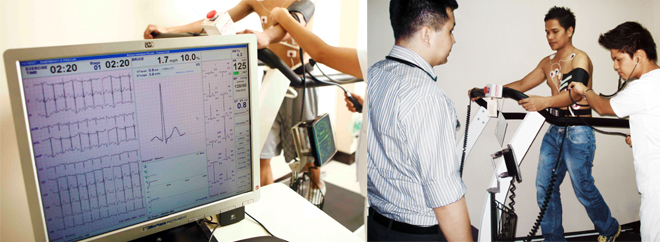
Treadmill Exercise Test is a cardiovascular stress test that assesses the response of the heart to increased workload and demand for blood during exercise. This is done by recording the electrical activity of the heart through an ECG and monitoring the blood pressure while the patient walks using a treadmill machine (Akinpelu 2011). The Treadmill Exercise Test is used to:
- estimate prognosis and determine functional capacity
- assess the probability and extent of coronary disease
- assess the effects of therapy
Reference:
Akinpelu, David. 2011. “Treadmill Stress Testing.” Emedicine.medscape.com. Accessed October 8, 2012. http://emedicine.medscape.com/article/1827089-overview.
Pure Tone Audiometry

Pure Tone Audiometry is an examination that tests the ability to hear sounds based on:
- Frequency (or pitch) - measured in cycles per second (cps) or Hertz
- Intensity (or volume) - speed of sound wave vibrations; measured in decibels (dB)
With the patient seated in a soundproof chamber within the audiometry room and made to wear earphones, each ear is tested separately using an audiometer which generates low and high-pitched tones of varying intensity (American Speech-Language-Hearing Association 2005). The test results are plotted on a special graph called an audiogram to show the pattern of hearing loss: conductive hearing loss, sensorineural hearing loss or mixed hearing loss.
Conductive hearing loss indicates an underlying problem either in the outer ear (specifically the ear canal) or the middle ear (see Fig. 1. Parts of the Ear). Conduction or movement of sound is blocked or does not pass into the inner ear. This may result in a temporary or permanent hearing loss. Causes of conductive hearing loss are the following:
Sensorineural hearing loss occurs as a result of damage to the inner ear (the spiral-shaped cochlea in particular) or to the eighth cranial nerve which is the vestibulocochlear nerve (also called the auditory nerve or acoustic nerve). Sensorineural hearing loss is usually permanent and the use of hearing aid is warranted. Causes of sensorineural hearing loss include:
|
Fig. 1. Parts of the Ear |
- hereditary syndromes or hearing loss that runs in the family
- otologic effects of aging (presbycusis)
- head trauma
- noise trauma or exposure to loud noise
- drugs that are toxic to hearing (e.g., gentamycin and neomycin)
- malformation of the inner ear
Mixed hearing loss involves a combination of sensorineural hearing loss and conductive hearing loss. Two or more medical conditions of the ear are often detected. In mixed hearing loss, the conductive component may be treated but the sensorineural component is usually permanent.
References:
American Speech-Language-Hearing Association. 2005. Guidelines for Manual Pure-Tone Threshold Audiometry. Guidelines. Accessed October 8, 2012. http://www.asha.org/policy/GL2005-00014.htm.
Saunders, Anne Z., Andrea V. Stein and Nancy L. Shuster. 1990. “Audiometry.” In Clinical Methods: The History, Physical, and Laboratory Examinations 3rd edition, edited by Henry Kenneth Walker, Wilbur D. Hall and John W. Hurst, Chapter 133. Boston: Butterworths. http://www.ncbi.nlm.nih.gov/books/NBK239/.
Spirometry
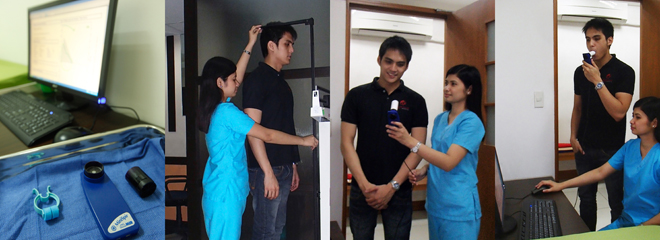
The Revised 2011 Global Strategy for the Diagnosis, Management and Prevention of Chronic Obstructive Pulmonary Disease (COPD), updated by the Global Initiative for Chronic Obstructive Lung Disease (GOLD), advises spirometry as the gold standard for accurate and repeatable measurement of lung function. In GOLD’s 2010 guide, the Spirometry for Healthcare Providers, spirometry does not only confirm the diagnosis of COPD but is also helpful in diagnosing patients with breathlessness and other respiratory symptoms and for screening in occupational environments. Using a spirometer, this will measure how much air can be inhaled as well as how much and how fast air can be exhaled by the patient.
Prior to the test, the doctor recommends certain medications or bronchodilators that should be avoided. Smoking, drinking alcohol and eating heavy meal are also discouraged within immediate hours of the test.
During the examination proper, the patient’s height and weight are measured. The patient is then asked to breathe through a mouthpiece. The test is done by instructing the patient to inhale rapidly and completely before exhaling with maximal force into the spirometer until no more air can be expelled. The test is repeated for a minimum of three maneuvers (and not to exceed eight) to make sure that the results are consistent and accurate.
References:
Global Initiative for Chronic Obstructive Lung Disease. 2010. Spirometry for Healthcare Providers. Accessed October 14, 2012. http://www.goldcopd.org/uploads/users/files/GOLD_Spirometry_2010.pdf.
Global Initiative for Chronic Obstructive Lung Disease. 2011. Global Strategy for the Diagnosis, Management and Prevention of COPD. Accessed October 14, 2012. http://www.goldcopd.org/uploads/users/files/GOLD_Report_2011_Feb21.pdf.
Psychological Examination

The minimum battery of psychological tests of the Department of Health (DOH) shall be applied to land-based overseas work applicants. Psychological screening and evaluation shall include, but are not limited to, the following (Department of Health 2013):
- Interview
- Autobiography
- DOH minimum battery of psychological tests, namely:
16 Personality Factors (16PF) Test
Developed by psychologist Raymond Cattell in 1949, the 16 Personality Factors (16PF) Questionnaire is an in-depth measure of the basic dimensions of personality. It measures the sixteen normal-range personality traits (Cattell and Mead 2008, 135): Warmth, Reasoning, Emotional Stability, Dominance, Liveliness, Rule-Consciousness, Social Boldness, Sensitivity, Vigilance, Abstractedness, Privateness, Apprehension, Openness to Change, Self-Reliance, Perfectionism and Tension. As these primary personality traits were factor-analyzed in succeeding research, five secondary global factors emerged, the Extraversion/Introversion, High Anxiety/Low Anxiety, Tough-mindedness/Receptivity, Independence/Accommodation, and Self-control/Lack of Restraint which closely correspond to the well-known Big Five Personality Traits, the Extraversion, Neuroticism, Openness, Agreeableness and Conscientiousness, respectively. Widespread use of the 16PF Test can be ascribed to major revisions of this questionnaire as well as to cultural adaptations, not just mere language translations.
Raven’s Progressive Matrices (RSPM) or Purdue Non-Language Test (PNLT)
The Raven’s Progressive Matrices, first developed by Dr. John Carlyle Raven in 1936 and published in 1938, is a test of general intelligence using matrices of geometric figures from which an examinee is to analyze the set pattern and then select among multiple choices the correct answer to complete the series. Ease of use and adequate standardization are the core attributes why this test is used internationally.
Purdue Non-language Test is also an intelligence test that uses geometric figures in ascertaining the abstract reasoning skill of the examinee. Prepared by Joseph Tiffin, Alin Grubner, and Kay Ibana at the Occupational Research Center in Purdue University, the Purdue Non-language Test is used across cultures because of its nonverbal format.
Other Psychological Screening and Evaluation Tests:
Draw-a-Person Test
The Draw-a-Person Test is a personality assessment tool developed and detailed by psychologist Karen Machover in a book she wrote in 1949, the Personality Projection in the Drawing of the Human Figure: A Method of Personality Investigation. In the Draw-a-Person Test, the examinee is asked to draw a man, a woman, and himself/herself. The dimensions shown on these drawings are then analyzed to reveal a personality profile of the examinee.
House-Tree-Person Test
The House-Tree-Person Test was developed by psychologist John N. Buck in 1948. This is a projective test aimed at inferring the examinee’s personality based on his drawings of a house, a tree and a person (Fahmy 2003).
Sacks’ Sentence Completion Test
This sixty-item sentence completion test developed by Dr. Joseph M. Sacks, Dr. Sidney Levy and other psychologists of the New York Veterans Administrative Mental Hygiene Service was depicted in the book, Projective Psychology Clinical Approaches to the Total Personality (Sacks and Levy 1950, 357). The objective of the test is to gain an understanding of the examinee’s dominant personality trends based on the clinical information elicited from the completed answers in four representative areas of adjustment such as Family, Sex, Interpersonal Relationship and Self-concept.
Bender Gestalt Motor Visual Test
This test was developed and published by child neuropsychiatrist Dr. Lauretta Bender in 1938 as Research Monograph No. 3 of the American Orthopsychiatric Association and appeared as "A Visual-Motor Gestalt Test and Its Clinical Use" to determine the ability of the examinee to integrate visual skills with motor skills (Woltmann 1950, 322). Test cards showing different figures are presented one at a time for the examinee to copy. The original test consists of nine geometric figures derived from the work of Gestalt psychologist Wertheimer. An updated edition, the Bender Gestalt II, consists of fourteen figures. The test yields results that reflect the examinee’s visual and perceptual functioning.
References:
Cattell, Heather E.P. and Alan D. Mead. 2008. “The Sixteen Personality Factor Questionnaire (16PF).” In The Sage Handbook of Personality Theory and Assessment, edited by Gregory J. Boyle, Gerald Matthews and Donald H. Saklofske, 135-159. London: SAGE Publications Ltd. http://books.google.com.ph/books?id=D5i3ShD10GkC&pg=PA134&lpg=PA134&dq=sage+handbook+16pf&source=bl&ots=8GQm9OElGW&sig=QlmFGB8m6M8Vls_t40xihwsl3tE&hl=en&sa=X&ei=G3epUd_6DobDkAWokoHYCw&ved=0CDAQ6AEwAA#v=onepage&q=sage%20handbook%2016pf&f=false.
Fahmy, Ali. 2003. “House-Tree-Person Test.” Gale Encyclopedia of Mental Disorders. Encyclopedia.com. Accessed September 16, 2012. http://www.encyclopedia.com/doc/1G2-3405700193.html.
Machover, Karen. 1949. Personality Projection: In the Drawing of a Human Figure. Springfield, IL: Charles C. Thomas. http://www.questia.com/read/206883/personality-projection-in-the-drawing-of-the-human.
Philippines. Department of Health. February 7, 2013. “Annex K: Basic DOH PEME for Overseas Work Applicants.” In Administrative Order No. 2013-0006, Subject: Guidelines to “Rule XI: Role of DOH in the Omnibus Rules and Regulations Implementing the Migrant Workers and Overseas Filipinos Act of 1995, as Amended by Republic Act No. 10022.” Posted February 15, 2013. Accessed May 27, 2013. http://bhfs.doh.gov.ph/images/issuances/hospital/annex%20k.pdf.
Raven, John. “The Nature, Development and Correlates of the Ability to Perceive and Form Orderly Judgments.” Dr. John Raven. Accessed September 30, 2012. http://www.johnraven.co.uk/index.html.
Sacks, Joseph M. and Sidney Levy. 1950. “The Sentence Completion Test.” In Projective Psychology Clinical Approaches to the Total Personality, edited by Lawrence Edwin Abt and Leopold Bellak, 357-402. New York: Alfred A. Knopf, Inc. http://www.archive.org/stream/projectivepsycho011575mbp/projectivepsycho011575mbp_djvu.txt.
Woltmann, Adolf G. I. 1950. “The Bender Visual-Motor Gestalt Test.” In Projective Psychology Clinical Approaches to the Total Personality, edited by Lawrence Edwin Abt and Leopold Bellak, 322-356. New York: Alfred A. Knopf, Inc. http://www.archive.org/stream/projectivepsycho011575mbp/projectivepsycho011575mbp_djvu.txt.
Optical Services
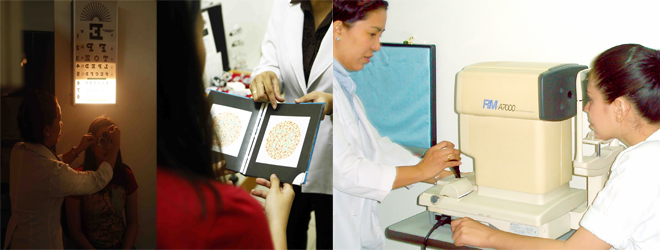
As ordered by Department of Health under Annex A, Technical Requirements of Administrative Order No. 181 s. 2004, an optometrist is required for medical facilities with more than 50 applicants per day. MedWay Healthcare Inc. abides by this directive by engaging the services of a licensed, full-time optometrist who conducts:
- Visual Acuity Test - to determine the sharpness of vision of the patient at near and far distances by identifying symbols or reading letters on an eye chart
- Eye Refraction Test - to determine the need for corrective glasses or contact lenses
- Color Vision Test - to check the patient’s ability to distinguish colors; the Ishihara Test, a commonly used test for color vision deficiency, detects Daltonism or color blindness of basic colors and are distinguished as:
- Protanopes - cannot not see red
- Deuteranopes - cannot see green
- Tritanopes - cannot see either blue or yellow; tritanopes cannot be identified using an Ishihara Test
Reference:
Philippines. Department of Health. September 9, 2004. “Annex A: Technical Requirements.” In Administrative Order No. 181 s. 2004, Subject: Revised Rules and Regulations Governing Accreditation of Medical Facilities for Overseas Workers and Seafarers. Posted December 20, 2004. Accessed September 8, 2012. http://home.doh.gov.ph/ao/ao181-04.pdf.
Dental Services
The dental examination, being part of a comprehensive oral examination, is a systematic process of inspecting the teeth and soft tissues of the mouth to check for:
- cavities between teeth, under the gum, on the root exposed by the receded gum, and cavities under restoration
- conditions and positions of the teeth, both impacted and erupted
- previous treatments such as crowns and restorations
- signs of gum disease
- periodontal pockets caused by gum disease
- signs of oral cancer
A review of the patient’s medical/dental history is a prerequisite to conducting dental examination. A careful history and clinical examination can detect lesions in the oral cavity including infectious, traumatic or reactive processes (Lynch 2012). Treatment options recommended are based on any of the above dental findings.
MedWay Healthcare Inc. offers the following dental services:
|
Oral Prophylaxis (Cleaning)
|
|
Light Cure (Laser) Filling
|
|
Tooth Extraction
|
|
Stomatitis (Aphthous Ulcer) Treatment |
|
Bleaching (Tooth Whitening)
|
|
Orthodontic Treatment (Braces, Alignment, Overjet, Overbite, Closing of Diastema)
|
|
Impacted Molar Treatment (Odontectomy/Surgery) |
|
Jacket Crown
|
|
Removable Denture Partial
|
|
Full Denture (Complete Denture)
|
|
Root Canal Treatment |
|
Post and Core Treatment |
Reference:
Lynch, Dennis P. 2012. “Oral Examination.” In Medscape Reference, edited by William D. James, Drore Eisen, James J. Nordlund, Catherine M. Quirk, Michael J. Wells. Updated March 20, 2012. Accessed October 15, 2012. http://emedicine.medscape.com/article/1080850-overview.
Vaccinations
MedWay Healthcare Inc. offers the following vaccinations (click the tabs to view description of Vaccines):
1. Tetanus-Diphtheria-acellular Pertussis (Tdap) Vaccine
Inactivated vaccine administered intramuscularly to adolescents and adults to provide protection against:
- Tetanus, a disease of the nervous system caused by Clostridium tetani, a bacteria usually found in soil, dust and manure; transmitted not from person to person but by means of bacterial spores that enter and infect the body of a person through a break in the skin causing painful muscle contractions affecting mainly the neck and abdomen as well as the facial muscles (risus sardonicus), jaw muscles (lockjaw) and backward arching of the head, neck and spine (opisthotonus).
- Diphtheria, an infectious disease of the upper respiratory tract and skin caused by the toxin produced by Corynebacterium diphtheriae; a characteristic feature is the pseudomembrane formation on the tonsils, pharynx and/or nasal cavity; modes of transmission are via airborne respiratory droplet, contact with exudates from infected skin lesion and occasionally by fomites.
- Pertussis (whooping cough), a contagious respiratory infection that is caused by Bordetella pertussis; a whooping sound is produced as the infected person inhales after a bout of violent and rapid coughing; transmission is by aerosol droplet predominantly when exposed to a coughing patient.
2. Influenza Vaccine
Trivalent inactivated vaccine administered intramuscularly (also intradermally for > 60 years old) to protect against influenza viruses that cause mild to severe respiratory infections via respiratory droplet inhalation, direct transmission (sneezing infected mucus directly into a person’s eyes, nose or mouth) and through indirect contact (hand-to-eye, hand-to-nose or hand-to-mouth transmission, either from contaminated objects or handshake contact).
3. Hepatitis B Vaccine
Inactivated vaccine administered intramuscularly that protects against Hepatitis B Virus (HBV) infection, a disease that affects the liver and is transmitted through unprotected sex with an infected partner, maternal-neonatal during labor or delivery, blood transfusion, percutaneous transmission in drug abusers, accidental needlestick injury or work exposure to infectious blood/body fluids.
4. Varicella Vaccine
Live attenuated vaccine administered subcutaneously to prevent Varicella, commonly known as chicken pox caused by Varicella-Zoster virus; exhibits the classic symptom of rashes that turn into itchy, fluid-filled blisters and then into scabs; this airborne disease spreads not only through coughing or sneezing but also by touching or breathing in the virus particles coming from the blisters.
5. Measles, Mumps, Rubella (MMR) Vaccine
Live attenuated vaccine administered subcutaneously to prevent:
- Measles, an infection caused by a paromyxovirus of the genus Morbilivirus that presents with fever, runny nose, cough, red eyes, sore throat followed by maculopapular rashes that proceed downward and outward; spreads from person to person either through respiratory droplets (coughing or sneezing) or direct contact with fluids from an infected person’s nose or throat.
- Mumps, a contagious disease caused by the Mumps virus that is transmitted via airborne or direct contact with infected droplet or saliva; manifests as fever, headache, muscle ache, anorexia, malaise followed by swelling of salivary glands (parotitis); complications include aseptic meningitis, encephalitis, deafness, pancreatitis, orchitis, oophoritis.
- Rubella, also called German measles, is caused by a togavirus of the genus Rubivirus, transmitted through airborne droplets from respiratory secretions (saliva, sputum, nasal mucus) of infected persons and presents in older children and adults with fever, headache, inflammation of the eyes (bloodshot eyes or pink eyes), runny nose, sore throat, malaise, muscle or joint pain, lymphadenopathy prior to appearance of the rash (usually 3-day rash in children); infection during the first trimester (first twelve weeks) of pregnancy may lead to serious birth defects such as heart problems, hearing and vision loss, intellectual disability and liver or spleen damage.
6. Pneumococcal Vaccine
- for adults, the available vaccines are the polysaccharide vaccine (PPSV23) administered intramuscularly or subcutaneously and the conjugate vaccine (PCV-13) administered intramuscularly as protection against Streptococcus pneumoniae, the causative agent of different types of pneumococcal disease that are transmitted through droplet inhalation such as pneumococcal pneumonia, bacteremia, meningitis and otitis media
- for children, a 7-valent pneumococcal conjugate vaccine (PCV-7) is locally available but not recommended for routine use
7. Human Papilloma Virus (HPV) Vaccine
- recombinant vaccine administered intramuscularly for the prevention of sexually transmitted infection caused by Human Papilloma Virus (HPV) of which forty types have been associated with cancer of the cervix, vulva, vagina, penis, anus, head, neck and respiratory tract
- 2 available HPV vaccines:
- Bivalent (Types 16, 18) for females only
- Quadrivalent (Types 6, 11, 16, 18) for females and males
- both Quadrivalent and Bivalent HPV vaccines are routinely given to adolescent males and females 10 years to less than 19 years
Additional Vaccine
Hepatitis A Vaccine
Inactivated vaccine administered intramuscularly used to prevent Hepatitis A Virus (HAV) infection transmitted by ingesting fecally-contaminated food or water or through direct contact with an infectious person (Philippine Society for Microbiology and Infectious Diseases and Philippine Foundation for Vaccination 2009).
Routinely recommended in areas with high prevalence of Hepatitis A infection (e.g., Asia), susceptible individuals at risk of exposure:
- travellers
- armed forces
- persons for whom Hepatitis A is an occupational hazard
- homosexuals
- IV drug users
- persons with multiple sexual partners
- contacts of infected persons
- people who work with hepatitis A virus in research settings
- people who work with infected non-human primates
- recipients of clotting factor concentrates
- people with chronic liver disease because of risk of fulminant Hepatitis A
Click the image below to see Table of Recommendations for Routine Immunization.
References:
Committee on Adult Immunization of Philippine Society for Microbiology and Infectious Diseases and Philippine Foundation for Vaccination. 2012. “Routine Immunization for Adults 2012.” Table. Philvaccine.org. Posted August 27, 2012. Accessed October 2, 2012. http://www.philvaccine.org/vaccination-schedules/adult-immunization-schedule/ROUTINE%20IMMUNIZATION%20FOR%20ADULTS%202012.jpg.
Philippine Society for Microbiology and Infectious Diseases and Philippine Foundation for Vaccination. 2009. “Handbook on Adult Immunization for Filipinos 2009." Accessed October 2, 2012. http://www.psmid.org.ph/contents/Handbook_on_Adult_Immunization_2009_(contents).pdf.


